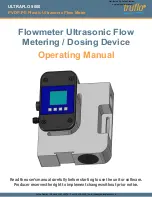
4
pins.) In many cases, it is also helpful to protect the
solder joint with heat-shrink tubing or epoxy.
Note: If you do not have the experience or resources to
attach pigtail leads, consult PCB to discuss factory
attachment. Damage caused by excessive heat is not
covered by warranty.
STEP 3:
Route the cable to the signal conditioner,
making certain to stress-relieve the sensor/cable
connection and minimize motion by clamping the cable
at regular intervals.
Certain precautions should be used to avoid physical
damage and minimize electrical noise. For instance,
avoid routing cables near high-voltage wires. Do not
route cables along floors or walkways where they may
be stepped on or become contaminated. Shielded cables
should have the shield grounded at one end only.
STEP 4:
Finally, connect the remaining cable end to the
signal conditioner. To dissipate charge that may have
accumulated in the cable, short the signal lead to the
ground lead prior to attachment.
6.0 POWERING
A conventional method for conditioning the high-
impedance signal generated by a charge output sensor is
to use a laboratory-style charge amplifier. The charge
amplifier converts the high-impedance charge signal
generated by the sensor to a low-impedance voltage
signal that can then be transmitted to a readout or a
recording device for analysis. Before connecting the
low-noise cable from the accelerometer to the charge
amplifier, be sure to ground both the charge amplifier
and the cable. This ensures that an excessive static
charge that may have accumulated across the
accelerometer or cable is harmlessly discharged. Failure
to observe this precaution can result in the destruction of
the input FET of certain amplifiers.
Once each element is connected, allow a few minutes for
the system to thermally stabilize. Place the switch on
the charge amplifier in the OPERATE position and
proceed with the measurement.
It is often convenient to normalize the accelerometer and
charge amplifier system to a precise sensitivity, such as
10.0 or 100.0 mV/g for ease of data analysis. This is
accomplished with most PCB laboratory charge
amplifiers and some miniature in-line units as well.
For fixed sensitivity in-line charge converters, such as
the PCB Series 422, the system sensitivity (mV/g) is
determined as the product of the charge amplifier
sensitivity (mV/pC) and the charge sensitivity of the
accelerometer (pC/g).
Note:
When using charge-amplified systems, the noise
floor of the system is dependent on the input
capacitance to the charge amplifier. Since the cable
adds to the capacitance and to minimize the noise
threshold, keep the cable length between the
accelerometer and the charge amplifier to a minimum.
Cable length does not affect the system sensitivity of
charge-amplified systems.
Since charge amplifier operation varies, please contact
the respective signal conditioner manufacturer or check
the product manual for additional information.
7.0 ACCELEROMETER CALIBRATION
Accelerometer calibration provides, with a definable
degree of accuracy, the necessary link between the
physical quantity being measured and the electrical
signal generated by the sensor. In addition, other useful
information concerning operational limits, physical
parameters, electrical characteristics, or environmental
influences may also be determined. Without this link,
analyzing data becomes a nearly impossible task. PCB
provides a calibration record that documents the exact
characteristics of each sensor. (The type and amount of
data varies depending on the sensor type, contractual
regulations, and other special requirements.)
Under normal operating conditions, piezoelectric
sensors are extremely stable, and their calibrated
performance characteristics do not change over time.
However, harsh environments or other unusual
conditions that cause the sensor to experience dynamic
phenomena outside of its specified operating range may
temporarily or permanently affect the sensor. This
change manifests itself in a variety of ways, including a
shift of the sensor resonance due to a cracked crystal, or
a temporary loss of low-frequency measuring capability
due to a drop in insulation resistance.
































